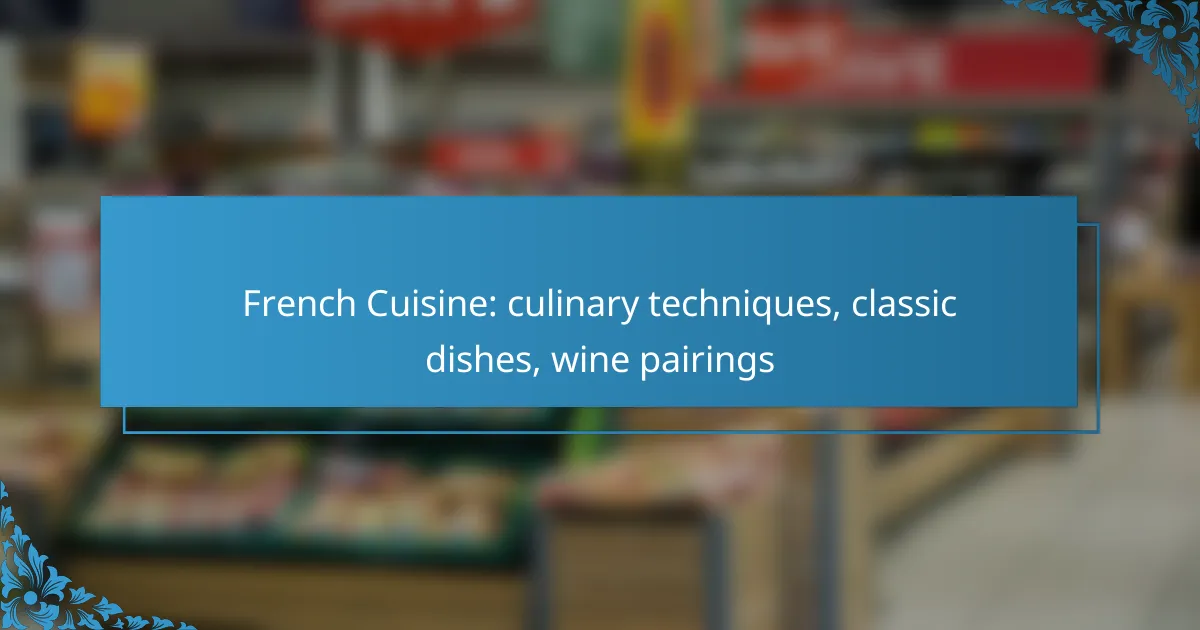French cuisine is renowned for its rich flavors and intricate techniques that form the backbone of its classic dishes. Mastering essential culinary methods allows chefs to create a diverse array of textures and tastes, elevating the dining experience. Iconic dishes like Coq au Vin and Ratatouille exemplify the country’s gastronomic heritage, while thoughtful wine pairings can further enhance these delightful flavors.
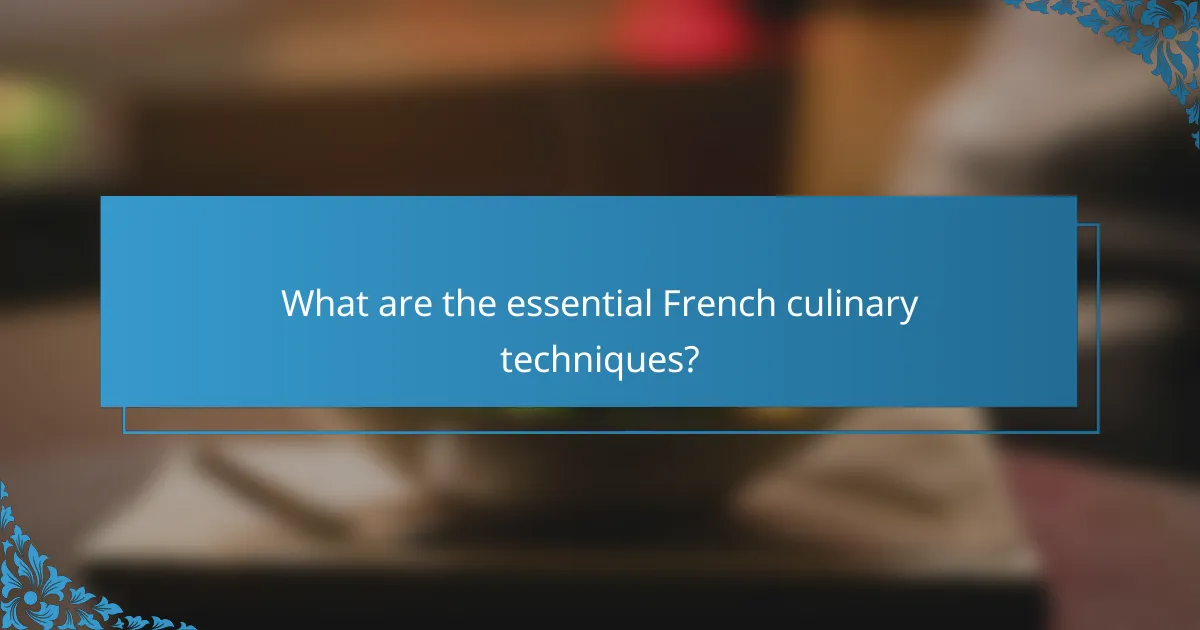
What are the essential French culinary techniques?
Essential French culinary techniques form the foundation of many classic dishes and are crucial for mastering French cuisine. Understanding these methods allows cooks to create a variety of textures and flavors, enhancing the overall dining experience.
Sautéing
Sautéing involves cooking food quickly in a small amount of fat over relatively high heat. This technique is ideal for vegetables and proteins, allowing them to develop a rich flavor while retaining moisture and texture. A common tip is to ensure the pan is hot before adding ingredients to achieve a nice sear.
For best results, use a heavy-bottomed pan and avoid overcrowding, which can lead to steaming rather than sautéing. Common ingredients for sautéing include onions, garlic, and various meats.
Braising
Braising is a combination cooking method that involves both dry and wet heat. Typically, food is first browned in fat and then cooked slowly in a covered pot with a small amount of liquid. This technique is perfect for tougher cuts of meat, as it breaks down connective tissues, resulting in tender, flavorful dishes.
Common braising liquids include stock, wine, or a combination of both. A classic example is coq au vin, where chicken is braised in red wine with mushrooms and onions.
Poaching
Poaching is a gentle cooking method that involves submerging food in simmering liquid, typically water, broth, or wine. This technique is often used for delicate proteins like fish and eggs, preserving their moisture and flavor without adding fat.
When poaching, maintain a temperature just below boiling to avoid toughening the food. A classic dish is poached salmon, often served with a light sauce or salad.
Confit
Confit is a preservation method where food, usually meat, is cooked slowly in its own fat. This technique not only enhances flavor but also extends shelf life. Duck confit, for example, is made by cooking duck legs in duck fat until tender and flavorful.
When preparing confit, ensure the food is fully submerged in fat to prevent spoilage. It can be served as a main dish or used in salads and other recipes.
Emulsification
Emulsification is the process of combining two immiscible liquids, such as oil and vinegar, to create a stable mixture. This technique is essential for making dressings, sauces, and mayonnaise. Achieving a successful emulsion requires slow incorporation of one liquid into the other while whisking vigorously.
Common emulsified sauces include vinaigrettes and hollandaise. A key tip is to use room temperature ingredients to help the emulsion hold together better.
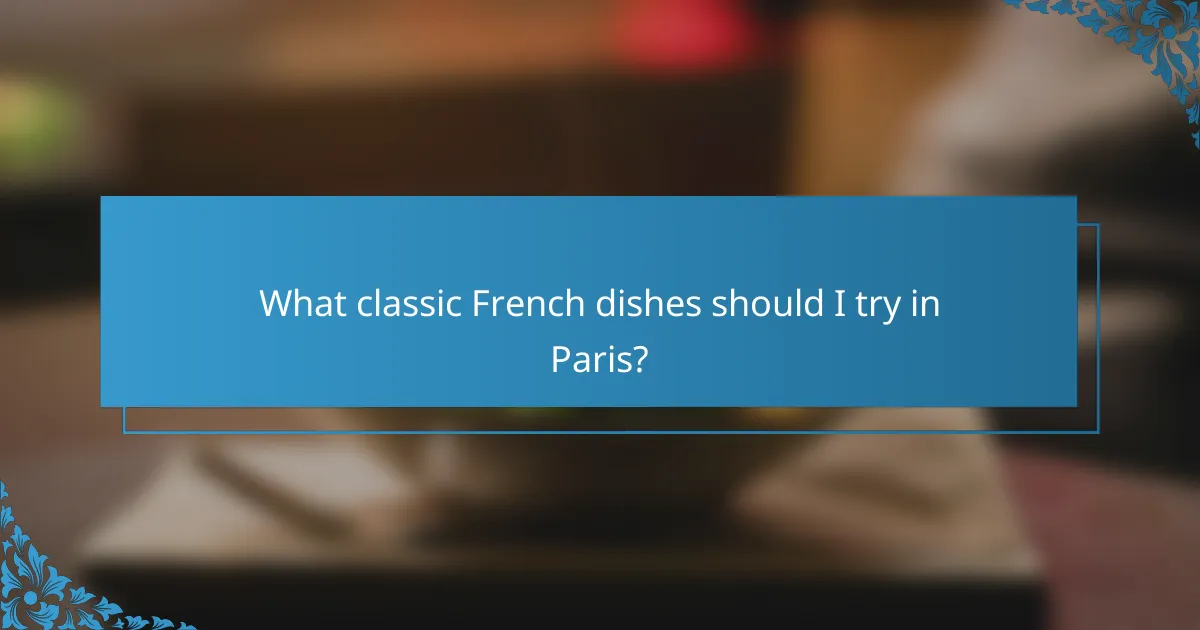
What classic French dishes should I try in Paris?
When in Paris, you should definitely try classic French dishes like Coq au Vin, Boeuf Bourguignon, Ratatouille, and Soupe à l’Oignon. Each dish showcases the rich culinary traditions of France and offers a unique taste of the country’s gastronomy.
Coq au Vin
Coq au Vin is a traditional French dish made with chicken braised slowly in red wine, often accompanied by mushrooms, onions, and bacon. The choice of wine is crucial; a full-bodied red like Burgundy enhances the flavors. This dish is typically served with crusty bread or potatoes to soak up the rich sauce.
When ordering Coq au Vin in Paris, look for establishments that prepare it using local wines and fresh ingredients. It’s a hearty option, perfect for a cozy dinner.
Boeuf Bourguignon
Boeuf Bourguignon is a classic beef stew braised in red wine, flavored with garlic, onions, and herbs. The slow cooking process tenderizes the meat and allows the flavors to meld beautifully. Traditionally, a robust red wine from Burgundy is used, which adds depth to the dish.
This dish is often served with mashed potatoes or crusty bread, making it a filling choice. Be sure to try it in a bistro that specializes in traditional French cuisine for an authentic experience.
Ratatouille
Ratatouille is a vegetable dish that originates from Provence, showcasing seasonal produce like zucchini, eggplant, and bell peppers. The vegetables are typically sautéed and then simmered with herbs, creating a flavorful and colorful dish. It’s a great option for vegetarians and pairs well with crusty bread or rice.
In Paris, you can find Ratatouille served as a side dish or as a main course. Look for restaurants that emphasize fresh, local ingredients to truly appreciate this classic dish.
Soupe à l’Oignon
Soupe à l’Oignon, or French onion soup, is a comforting dish made from caramelized onions, beef broth, and topped with melted cheese and crusty bread. The sweetness of the onions combined with the savory broth creates a rich flavor profile. It’s often enjoyed as an appetizer or a light meal.
When enjoying Soupe à l’Oignon in Paris, seek out places that prepare it with a generous amount of cheese and a well-seasoned broth. This dish is particularly satisfying during the colder months.
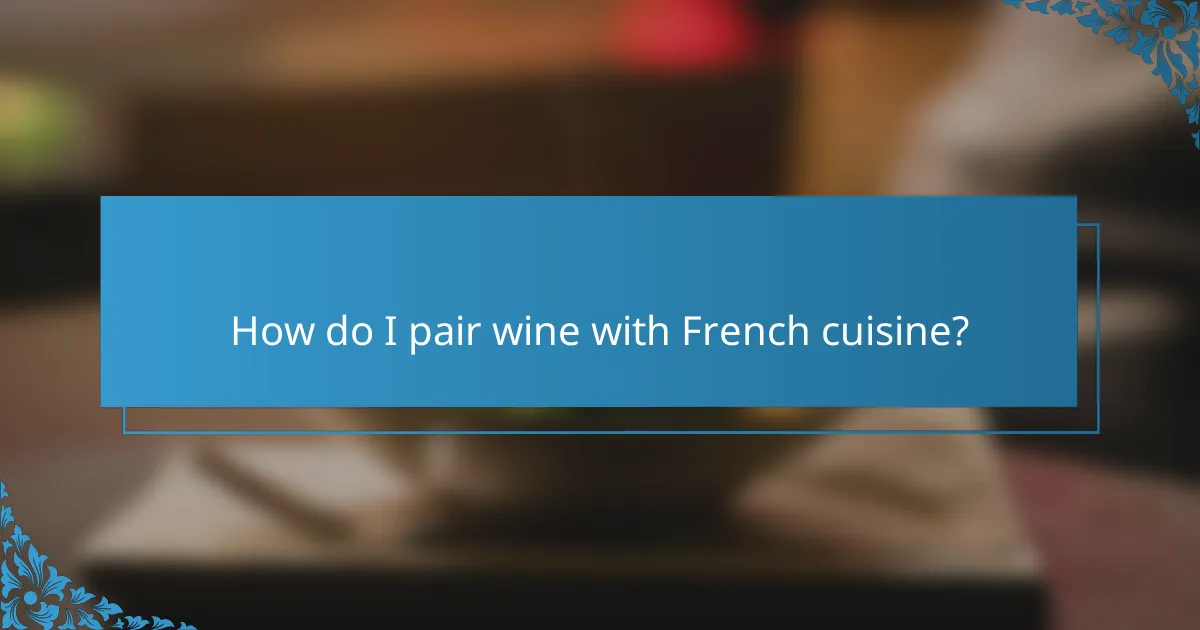
How do I pair wine with French cuisine?
Pairing wine with French cuisine involves matching the wine’s characteristics with the flavors of the dish. Consider the main ingredients, cooking methods, and overall richness to enhance the dining experience.
Red wine with Beef Bourguignon
Beef Bourguignon, a classic French stew, pairs excellently with a full-bodied red wine, such as Pinot Noir or Merlot. The wine’s acidity complements the rich, savory flavors of the beef and the depth of the sauce.
When selecting a red wine, look for one with moderate tannins to avoid overpowering the dish. A good rule of thumb is to choose a wine from the same region as the dish, like a Burgundy, to create a harmonious pairing.
White wine with Coquilles Saint-Jacques
Coquilles Saint-Jacques, featuring scallops in a creamy sauce, is best enjoyed with a crisp white wine, such as Chardonnay or Sauvignon Blanc. The wine’s acidity cuts through the richness of the dish, balancing the flavors beautifully.
Opt for a white wine that has undergone some aging for added complexity, or choose one with citrus notes to enhance the dish’s freshness. A Chablis, known for its minerality, is an excellent choice to complement the scallops.
Rosé with Ratatouille
Ratatouille, a vegetable medley, pairs well with a dry rosé, which offers a refreshing contrast to the dish’s earthy flavors. The lightness of rosé enhances the freshness of the vegetables without overwhelming them.
When selecting a rosé, consider one with bright acidity and fruity notes, such as those from Provence. This choice will elevate the dish while maintaining a balance between the wine and the vibrant flavors of the ratatouille.
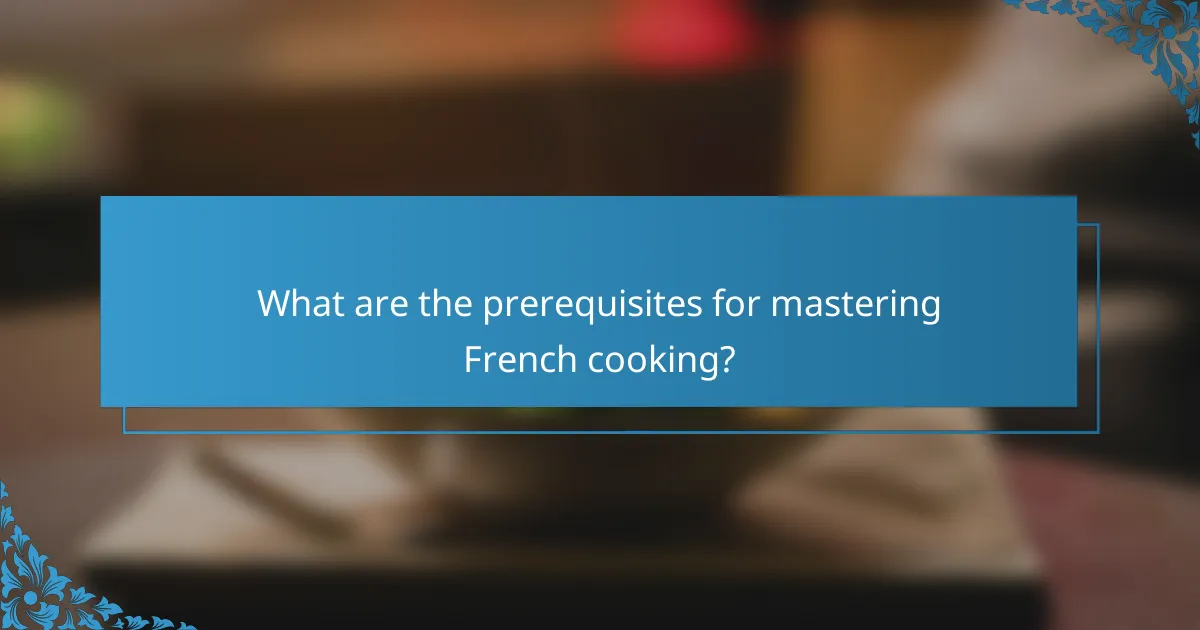
What are the prerequisites for mastering French cooking?
To master French cooking, one needs a solid understanding of culinary techniques, a familiarity with key ingredients, and proficiency with essential kitchen tools. These foundational elements will enable you to create authentic dishes and appreciate the nuances of this rich culinary tradition.
Understanding French ingredients
French cuisine relies heavily on high-quality, fresh ingredients. Familiarity with staples such as herbs de Provence, shallots, and various cheeses is crucial. Knowing how to select seasonal produce and understanding the significance of regional specialties can elevate your cooking.
For example, using fresh herbs like thyme or tarragon can enhance the flavor profile of a dish. Additionally, understanding the role of fats, such as butter and olive oil, is essential for achieving the desired texture and taste in classic recipes.
Familiarity with kitchen tools
Having the right kitchen tools is vital for effective French cooking. Essential items include a chef’s knife, a mandoline for slicing, and various pans like a sauté pan and a Dutch oven. Each tool serves a specific purpose that can affect the outcome of your dishes.
For instance, a heavy-bottomed pan is ideal for browning meats, while a non-stick skillet is better for delicate items like crepes. Investing in quality tools will not only make cooking easier but also help you achieve professional results.
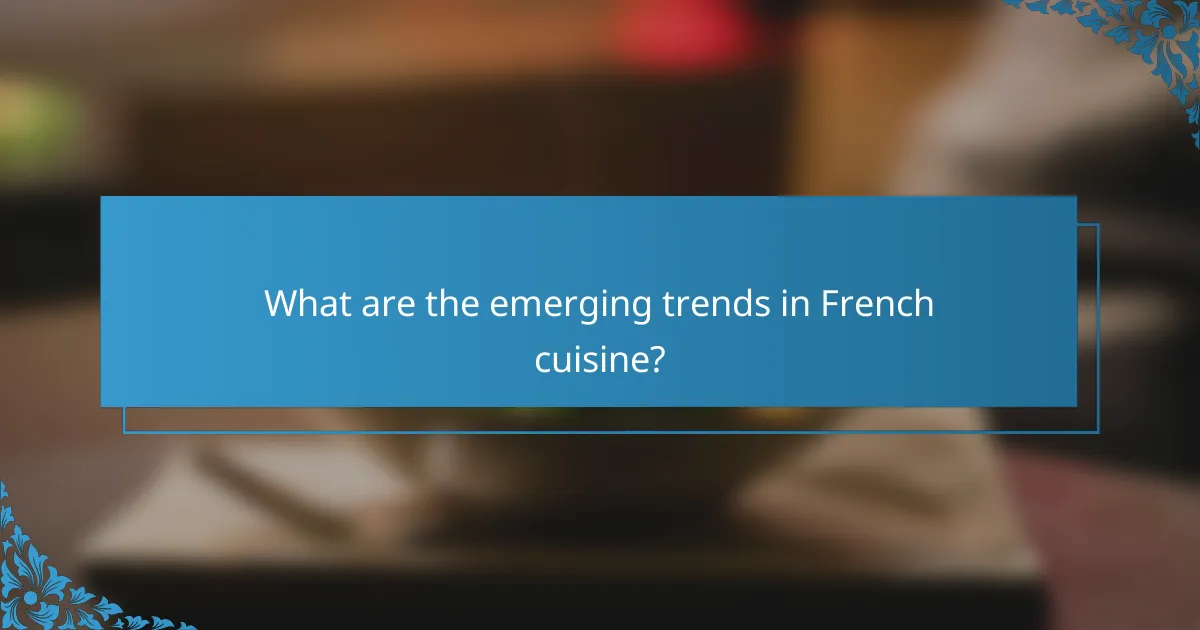
What are the emerging trends in French cuisine?
Emerging trends in French cuisine emphasize sustainability, innovation, and a return to traditional methods. Chefs are increasingly focusing on local ingredients and environmentally friendly practices, while also experimenting with global flavors and techniques.
Farm-to-table practices
Farm-to-table practices in French cuisine prioritize sourcing ingredients directly from local farms, ensuring freshness and quality. This approach not only supports local economies but also reduces the carbon footprint associated with food transportation.
Chefs often collaborate with nearby producers to create seasonal menus that reflect the best available ingredients. For instance, a restaurant might feature dishes made with organic vegetables from a local farm or artisan cheeses from a nearby dairy.
To implement farm-to-table practices, restaurants should establish relationships with local farmers, attend farmers’ markets, and consider joining cooperatives. This not only enhances the menu but also builds a community around sustainable food practices.
